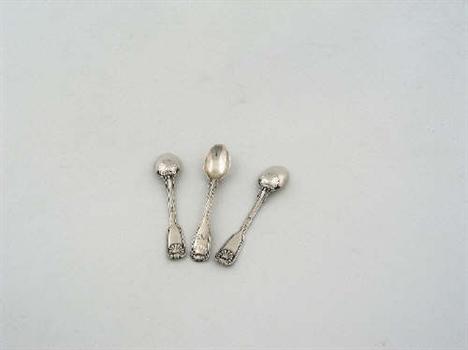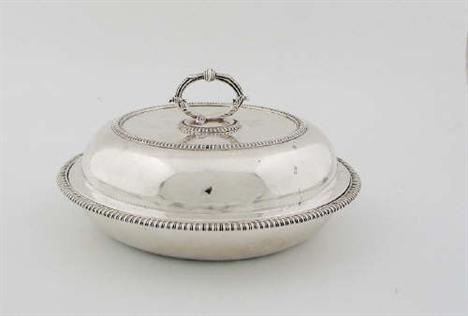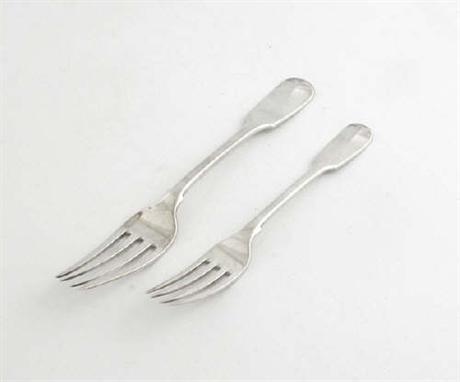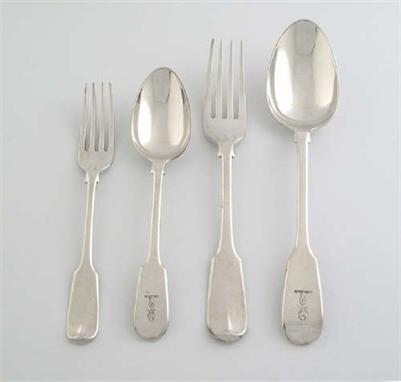We found 2151 price guide item(s) matching your search
There are 2151 lots that match your search criteria. Subscribe now to get instant access to the full price guide service.
Click here to subscribe- List
- Grid
Impressive pair of Victorian circular tureens and covers by Hunt & Roskell, the lobed domed lids with a naturalistic foliate C-scroll cast handles, the stand with gadrooned and foliate scrolls and supported on four outswept foliate scroll legs, 8" high x 11.25" diameter, London 1845, stamped 'Hunt & Roskell late Storr & Mortimer', 136oz approx
A William IV Teapot, Paul Storr, London 1833, stamped "Storr & Mortimer", compressed circular body raised on a collet foot with a leaf capped scroll handle and domed cover with a fruiting finial, foliate chased throughout, initialled "HD" for Hugh Delamere, 2nd Baron Delamere, 12.5cm high, 26oz 12dwt all in See illustration
A 19th Century extensive matched king's pattern table service by Paul Storr and others, comprising forty-eight table forks (six by Storr), forty-six dessert forks (six by Storr), forty-eight dessert spoons (six by Storr), thirty table spoons (six by Storr), thirty-six tea spoons (six by Storr), five basting spoons, a soup ladle, six sauce ladles, a fish slice, a pair of sugar tongs, various dates and makers, London 1820 to 1863, in a metal-bound travelling case (222)
A Victorian three-piece tea service of circular bombe form with embossed flowerhead, foliate and scroll decoration, having a flower finial with maskhead terminals to the handles, on maskhead feet, crested, the teapot 25.5cm. long, John Samuel Hunt, stamped 'HUNT & ROSKELL, LATE STORR & MORTIMER', London 1850 and 1852, 1565gm., 50.32oz.
A George III silver salver, the pie crust edge with scrolling acanthus and shell decoration raised on four scrolling shell, grape and vine decorated feet, the centre field engraved with the inscription "Presented by The Officers and Crew of HMR Cutter Greyhound to John Nugent Esq. Lieu.t RN as a mark of their high respect for his officer like conduct and as a token of gratitude for his fatherly attention during the three years they have had the honor of serving under his command" within a ribbon tied foliate border surmounted by a cockerel headed two legged dragon, dated "Jan.y 1820" above a scroll inscribed "Palmam qui meruit ferat" (by Paul Storr, London 1819), 32.5 cm diameter, 39 oz (ILLUSTRATED)
MARGOLIOUTH, D.S. 'Cairo, Jerusalem & Damascas', Ill. W.S.S. Tyrwhitt & Reginald Barratt, Chatto & Windus, 1907. 4to. glt. cl. Tog.with STORR, Ronald, 'Orientations', Nicholson & Watson, 1943. 4to. cl. bd. bumped. plus DOUGHTY, C.M. 'Arabia Deserta', Cape, 1928, Thin paper edn. plus similar interest. 18
By Paul Storr: A George III cushion-shaped entree dish and cover, with gadrooned borders, incurved corners and a large foliate handle at each end, the cover with a detachable reeded handle terminating in lion masks and adorned with applied honeysuckle flowers, London 1808, 13.4in (34cm) long, 76oz.
gill (M.A.V.) A Directory of Newcastle Goldsmiths, 1980 4to., 378 pages, card covers, (detached, lacking backstrip; Grimwade (A.G.) London Goldsmiths, 1697-1837, Their Marks and Lives, 1976, dw.; Penzer (N.M.) Paul Storr, 1954, lg. 4to., dw.; Krohn-Hansen (T.) Trondhjems Gullsmedkunst, 1550-1850, 1963, ltd. ed., dw.; with A Quantity of Volumes on gold and silver (qty.)
A William IV silver gilt chamberstick by Paul Storr, London 1832, the circular multifoil base chased with strawberry fruits, flowers and leaves within a scrolled border, the socket of vase shape with conforming chasing and scrolled nozzle, the handle complete with conical extinguisher, 15cm diameter, 14.25oz
A set of five Regency dinner plates By Paul Storr, London 1820, with foliate and shell cast detail to points and gadrooned border between and with engraved family armorials(5) 27cm diameter 22oz each Notes: The arms of FOX quartering LANE impaling PITT for the marriage (23 July 1789) of James FOX-LANE, of Bramham Park, Yorkshire, MP for Horsham and successor to the great estates in England and Ireland of his uncle Lord Bingley, of Bingley, Yorkshire who died in 1773 having inherited the great estates of Lord Lanesborough who died in 1724. With Hon. Marcia Lucy, daughter of George PITT, Baron Rivers of Strathfieldsaye and later Baron Rivers of Sudeley Castle, Glos. James Fox-Lane died in 1821.
The trophy for the 1864 Royal Hunt Cup at Ascot: in the form of a large silver shallow dish & cover centrepiece, hallmarked London, 1863, maker's mark of John Samuel Hunt for Hunt & Roskell, inscribed on foot rim HUNT & ROSKELL LATE STORR & MORTIMER 2327, designed as a shallow dish and cover on an elegant stepped stem and base, the lid surmounted by models of stags, all on a stepped ebonised plinth with two friezes of stags and deer in raised relief in between Queen Victoria's royal coat of arms, the base with two sculptural still lifes of a jockey's cap, saddle, stirrups and whip resting on laurel, and with two plaques inscribed ASCOT, 1864, WON BY, MR. LONGFIELD'S GEM OF THE SEA, 4 YEARS OLD, CARRYING 7ST. 10LB., overall height of trophy when on plinth, 87.5cm., 34 1/2in., diameter of dish 39cm., 15 1/4in. Mr Longfield's Gem of the Sea caused an upset in the 1864 Royal Hunt Cup at Ascot by winning at odds of 40 to 1 under a ride from Harry Grimshaw. He beat 33 other runners and survived an objection on the grounds of crossing. The Royal Hunt Cup was first contested in 1843 and remains one of the highlights and great gambling races of the Royal meeting. The design of this trophy is a direct reference to the Royal Hunt at Windsor Park, from which the famous handicap at Royal Ascot derived its name. This also explains the presence of the Royal Coat of Arms engraved on the trophy. Stag were hunted by the Royal Buckhounds. It is typical of the high Victoriana offered as trophies on the racecourse at this period, particularly for the major races at Royal Ascot, Goodwood and the Doncaster St Leger meeting. The trophy was valued in the Racing Calendar at 200 sovs.
The trophy for the 1881 Chesterfield Cup at Goodwood: in the form of a Victorian silver sculptural group by Hunt & Roskell titled 'Sir Roger de Coverley and the Gypsies, Spectator,' hallmarked London, 1881, modelled with Sir Roger dismounted from his horse and having his palm read by the older of two gypsy women, in front of two dogs besides a suspended cauldron, all on a naturalistic base with a title plaque, on a large ebonised plinth set with a plaque inscribed GOODWOOD, 1881, with the original oak fitted carrying case bearing a printed paper label for Hunt & Roskell/Storr & Mortimer, with key, the group 37cm., 14 1/2in. high, 47cm., 18 1/2in. long and 34cm., 13 1/2in. wide. Sir Roger de Coverley was the name of a character by Addison in The Spectator published in 1711. An English squire of Queen Anne's reign, Sir Roger exemplified the values of an old country gentleman, and was portrayed as lovable but somewhat ridiculous ("rather beloved than esteemed," to quote from the text), and making his Tory politics seem harmless but silly. He is said to be the grandson of the man who invented the Coverley, an English and Scottish country dance with its steps reminiscent of a hunted fox going in an out of cover. The modelling of this sculptural group is based on Sir Roger's essay XVII in The Spectator when Sir Roger whilst riding out with a friend encounters two gypsy women, where upon his palm is read and the bachelor told that "... he is dearer to someone than he thinks." This same literary incident had earlier inspired the artist Charles Robert Leslie R.A. (1794-1859), born in London to an American family from Maryland, who exhibited a picture with this subject to kind reviews in 1829. Additionally, a similar group to the present sculpture is described in the 1851 Great Exhibition catalogue listed under 111 of the works in precious metals section designed and manufactured by Joseph Angell of the Strand. Hunt & Roskell's trophy was presented as the prize for the 1881 running of the Chesterfield Cup (Handicap) at the main Goodwood July festival meeting and was won Mr Henry Bragg's four-year-old colt Victor Emanuel ridden by John Osborne. The trophy was valued at 300 sovs. in the Racing Calendar and this was the prize for the victory, there were no cash winnings. It is typical of the high Victoriana offered as trophies on the racecourse at this period, particularly for the major races at Royal Ascot, Goodwood and the Doncaster St Leger meeting. Nearly always a horse forms part of the design but very often not in any sporting context. Literary inspiration, as is the case here, was often a favourite choice of designers. The winner of the race was Victor Emanuel, a son of the stallion Albert Victor who had finished second in both the Derby and St Leger but was the winner of many good races including the Middle Park Stakes, the Ascot Gold Vase and the Great Ebor Handicap. Victor Emanuel carried 8st. 5lb. and won the race by a length at odds of 100 to 6. PROVENANCE: Mr Henry Bragg, the winning racehorse owner of the 1881 Chesterfield Cup, Goodwood, and thence by family descent.
A modern limited edition 18ct gold wine label, cast in the form of the Royal Lion on a textured title area, pierced 'BORDEAUX' by Michael. W. Druitt, London 1972 (in original box), 3.15in (8cm) wide, 2oz. *This is a copy of a type made by Paul Storr in 1811. The originals being in the Royal Collection.
A fine Regency silvergilt presentation cup in the form of a Warwick vase wine cooler, on a coppergilt plinth, the vase cast with masks, vine tendril handles and two lion pelts with texturing below a frieze of fruiting vines, with lift-off collar and screw in liner, both crested, the foot engraved with a coat of arms and inscribed "Presented by the Officers of the 7th (Queens OWN) Hussars to Col. Edward Kerrison in token of the Respect excited by his Conduct At the Battle of Orthes 27th February 1814 and as a mark of the Regard & Esteem they feel towards him August 1814" the plinth with an upper border of tongue and dart, and lower border of stiff leaves, two sides with applied wreathes and other two with an engraved coat of arms the vase by Paul Storr, London 1814, stamped around the foot "RUNDELL BRIDGE ET RUNDELL AURIFICES REGIS ET PRINCIPIS WALLIAE REGENTIS BRITANNIAS" the plinth stamped "STORR & MORTIMER", height of vase, 9.5in (24.2cm) high, overall height with plinth 17.75in (45.2cm) high, 208 oz weighable silver. Sir Edward Kerrison 1776-1853. 1796 Cornet in the 6th (Inniskilling) dragoons promoted Captain 1798 transferred to 7th Hussars promoted Major in 1803 and Lieutenant Colonel in 1805. In October 1808 he embarked with the 7th for Spain and in December of that year was severely wounded on the plains of LEON. He commanded the 7th at the passage of OLERON, the action of SAUVETERNE, and at the battles of ORTHEZ and TOULOUSE. At the battle of ORTHEZ the charge headed by LORD EDWARD SOMERSET in which the chief part was highly commended by WELLINGTON. In 1813 he was promoted Brevet Colonel. KERRISON served in the 1815 compaign and was slightly wounded at Waterloo, where his horse was shot from under him; but he continued with his regiment, and took part in the occupation of PARIS. He was knighted on 5 January 1815; was made CB on 22 June 1815 and KCH in 1821 and created a baronet by patent dated on 27 July 1821; he was made GCH in 1831 and KCB on 18 July 1840. He was tory MP for Shaftesbury 1812 to 1818, for Northampton from 1818 to 1824 and for Eye, which he had purchased from 1824 to 1852. Promoted Lieutenant General in 1837, he became a General in 1851. OXFORD DICTIONARY OF NATIONAL BIOGRAPHY.
A late George III Paul Storr silver goblet, with gilded interior wide applied band of fruiting vine, the base of the bowl chased with acanthus leaves on circular foot with leaves and inscription 'Bridge et Rundle Aurifices Regis et Principis Wallie Regentis Britannias', London 1817, numbered underneath 192, height 6.5in. 14.5 oz.


















































